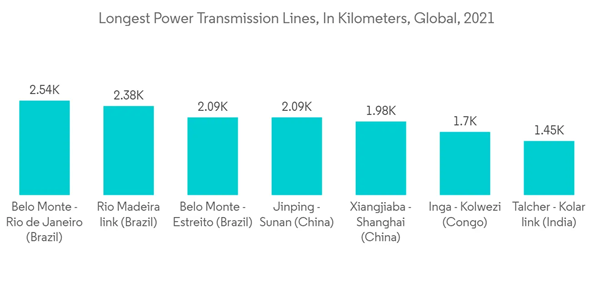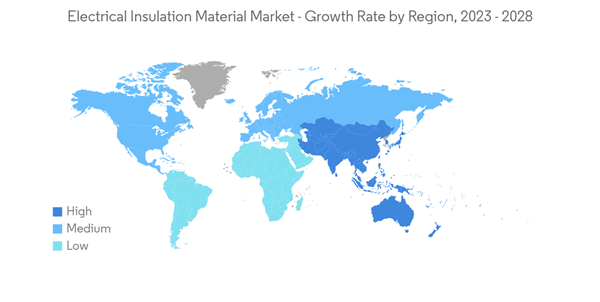The COVID-19 pandemic significantly influenced the market for electrical insulation materials, owing to worldwide limitations that affected most industries. However, the industries accelerated from 2021, thus increasing the demand for electrical insulation material. Therefore, the market will likely maintain a similar trajectory during the forecast period.
Key Highlights
- The increasing safety precautions in electrical equipment are increasing the growth of the electrical insulation materials market throughout the forecast period. Moreover, the need for electricity transmission and distribution to various places in different regions worldwide is driving market growth.
- On the contrary, the high costs of electrical insulation materials are a significant factor hampering the market growth. It is also expected to be challenging for the global electrical insulation materials market.
- The increasing power generation activities in developing countries and the growing demand for electrical insulation materials in electric vehicles will likely be an opportunity for the market studied.
- Asia-pacific dominated the market for electrical insulation materials owing to the highly improved power sectors and rapid industrialization in emerging economies. At the same time, Asia-pacific is also expected to register the highest CAGR during the forecast period.
Electrical Insulation Material Market Trends
Transmission and Cable Lines Application to Dominate the Market
- Electrical insulation materials don't allow electricity to pass through them. Electrical insulation materials are applied in transmission and cable lines, generators, electrical rotating machines, transmissions, and transformers.
- Transmission cables transport electricity from power production areas to various locations. Generators, transformers, and spinning machinery are part of the power generation industry. Insulation materials allow electricity to travel through transmission or cable lines without disruption or energy wastage.
- According to Power Technology, the top three most extended power transmission lines in the world as of 2021 were in Brazil. With a length of 2,543 km, the Belo Monte-Rio de Janeiro transmission line came in first, followed by the Rio Madeira transmission link and the Belo Monte-Estreito line.
- According to the US Department of Energy estimation, approximately 200 miles of electrical transmission lines will be covered in the United States in 2021. Projects with voltages of up to 230 KV accounted for nearly 52% of the total length completed that year.
- Projects with voltages of up to 230 KV traveled around 101 miles. The remaining 92 miles were covered by projects with voltages ranging from 230 to 345 KV.
- Many projects are underway to lay the transmission line for safe power transmission from one location to another. For example, PacifiCorp's Southeastern Idaho project, scheduled to be finished in April 2022, aimed to replace outdated transmission lines with newer ones to fulfill the region's rising demand for electrical power. The project required a multi-stage electrical system upgrade from Goshen Substation near Firth, Idaho, to Rexburg Substation in Rexburg, Idaho.
- The expansions, as mentioned above, in the transmission cables and the new projects substantially increased the demand for electrical insulation materials.
Asia-Pacific Region to Dominate the Market
- The Asia-Pacific region is expected to dominate the global market owing to the highly developed power sector, and rapid industrialization witnessed in China and India in the energy services sector recently.
- The region's electricity demand is expected to rise as household incomes increase and power consumption in various applications rises. Rotating electric machines that convert electrical energy into mechanical energy use insulation materials for better electricity transmission inside the machine parts without passing through materials.
- Two of China's power transmission lines are among the world's top five most extended transmission lines as of 2021. The first is the 2,090 km long Jinping-Sunan transmission line, ranked fourth worldwide, followed by the 1,980 km long Xiangjiaba-Shanghai transmission line.
- According to the Ministry of Power, Government of India, the country became one of the world's most extensive synchronous interconnected electricity grids with 4,63,758 circuit km of transmission line and 11,56,105 MVA of transformation capacity as of January 2023.
- The Ministry of Land, Infrastructure, Transport, and Tourism also stated in its report that in the fiscal year 2021, the value of orders for the construction of electric power lines received by 50 primary constructors in Japan amounted to approximately JPY 258.36 billion (~USD 2.35 billion). It, however, represents a decrease of 6.6% compared to the previous year.
- Electric insulating materials are also necessary for the electric vehicles business. Electrical insulation comprises non-conductive materials that regulate the electricity flow and safeguard sensitive components. It enables the safer adoption of these new technologies since they are adequately protected from electrical currents, preventing fires and guaranteeing that the electric energy stays on the appropriate path and does not interact with other components, resulting in short-circuiting.
- In addition, insulators safeguard EV onboard chargers, DC/DC converters, power electronics controllers, DC charging stations, and the battery management system. According to the Chinese Association of Automobile Manufacturers, sales of New Energy Vehicles surged by 93.4% in 2022 over 2021. Overall sales of new energy vehicles were roughly 6.8 million by the end of 2022, compared to only about 3.5 million sales for the entire year in 2021. This growth in EV production and sales in the country will undoubtedly raise market demand.
- Therefore, the increasing electricity usage in industries and the usage of the increasing material in EV production are expected to drive the market for electrical insulation material through the years to come in the Asia-Pacific region.
Electrical Insulation Material Industry Overview
The electrical insulation material market is fragmented, with many players competing. Some major companies (not in particular order) are General Electric, Owens Corning, ABB, Siemens, and Huntsman.Additional Benefits:
- The market estimate (ME) sheet in Excel format
- 3 months of analyst support
This product will be delivered within 2 business days.
Table of Contents
1 INTRODUCTION1.1 Study Assumptions
1.2 Scope of the Study
2 RESEARCH METHODOLOGY
3 EXECUTIVE SUMMARY
4 MARKET DYNAMICS
4.1 Drivers
4.1.1 Growing Demand from Transmission and Distribution Systems
4.1.2 Other Drivers
4.2 Restraints
4.2.1 High Costs of Electrical Insulation Materials
4.2.2 Other Restraints
4.3 Industry Value Chain Analysis
4.4 Porter's Five Forces Analysis
4.4.1 Bargaining Power of Suppliers
4.4.2 Bargaining Power of Consumers
4.4.3 Threat of New Entrants
4.4.4 Threat of Substitute Products and Services
4.4.5 Degree of Competition
5 MARKET SEGMENTATION (Market Size in Value)
5.1 Type
5.1.1 Glass Insulator
5.1.2 Porcelain Insulator
5.1.3 Polymer Insulator
5.2 Voltage
5.2.1 Low Voltage
5.2.2 Medium Voltage
5.2.3 High Voltage
5.3 Application
5.3.1 Transformers and Bushings
5.3.2 Cables and Transmission Lines
5.3.3 Rotating Machines
5.3.4 Surge Protector and Circuit Breaker
5.3.5 Others
5.4 Geography
5.4.1 Asia-Pacific
5.4.1.1 China
5.4.1.2 India
5.4.1.3 Japan
5.4.1.4 South Korea
5.4.1.5 Rest of Asia-Pacific
5.4.2 North America
5.4.2.1 United States
5.4.2.2 Canada
5.4.2.3 Mexico
5.4.3 Europe
5.4.3.1 Germany
5.4.3.2 United Kingdom
5.4.3.3 France
5.4.3.4 Italy
5.4.3.5 Rest of Europe
5.4.4 South America
5.4.4.1 Brazil
5.4.4.2 Argentina
5.4.4.3 Rest of South America
5.4.5 Middle-East and Africa
5.4.5.1 Saudi Arabia
5.4.5.2 South Africa
5.4.5.3 Rest of Middle-East and Africa
6 COMPETITIVE LANDSCAPE
6.1 Mergers and Acquisitions, Joint Ventures, Collaborations, and Agreements
6.2 Market Share (%)/Ranking Analysis**
6.3 Strategies Adopted by Leading Players
6.4 Company Profiles
6.4.1 ABB
6.4.2 BASF
6.4.3 Bharat Heavy Electricals Limited
6.4.4 General Electric
6.4.5 Huntsman
6.4.6 Knauf Insulation Group
6.4.7 Krempel GmbH
6.4.8 NGK Insulators
6.4.9 Owens Corning
6.4.10 Siemens
6.4.11 Toshiba
6.4.12 Von Roll
7 MARKET OPPORTUNITIES AND FUTURE TRENDS
7.1 Increasing Power Generation Activities in Developing Countries
7.2 Growing Demand for Electrical Insulation Materials in Electric Vehicles
7.3 Other Opportunities
Companies Mentioned (Partial List)
A selection of companies mentioned in this report includes, but is not limited to:
- ABB
- BASF
- Bharat Heavy Electricals Limited
- General Electric
- Huntsman
- Knauf Insulation Group
- Krempel GmbH
- NGK Insulators
- Owens Corning
- Siemens
- Toshiba
- Von Roll










